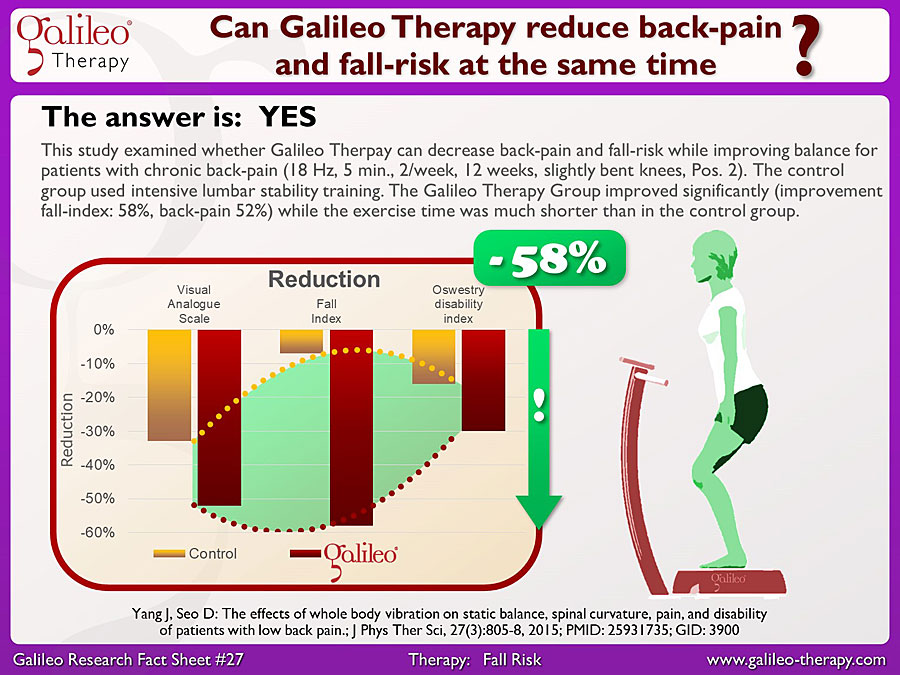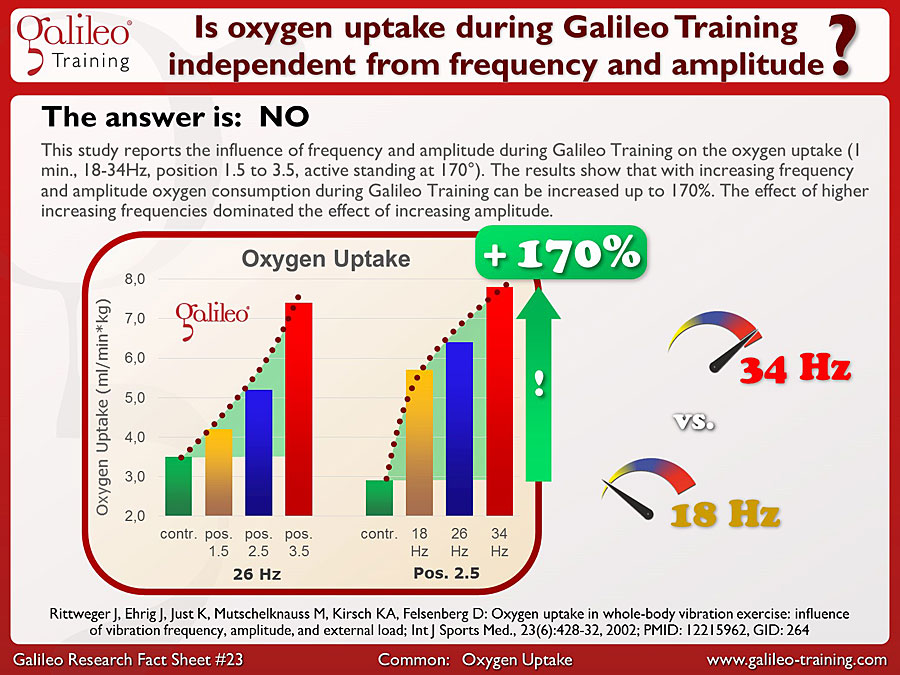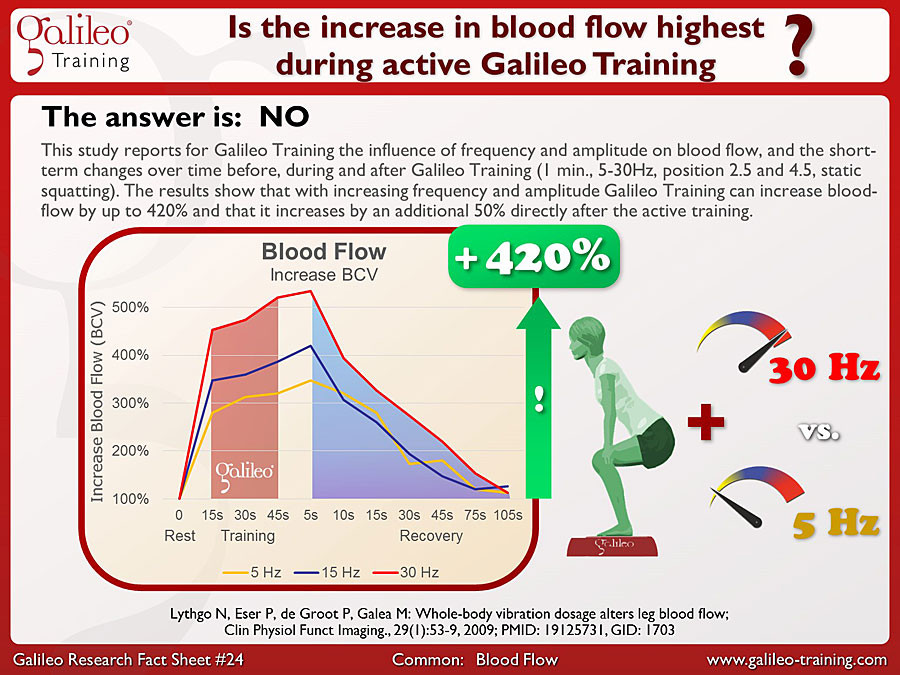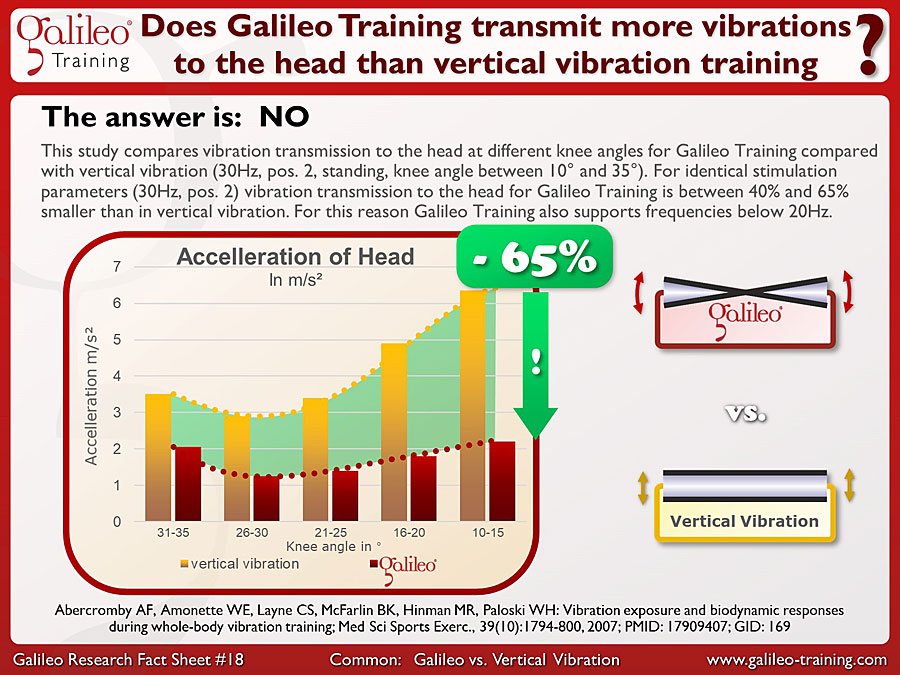This study used Galileo Training in rest phases between High Intensity Training (HIT) intervals to reduce loss of anaerobic power (20 Sessions HIT, HIT+18Hz/HIT+30Hz, 3 min., pos. 3, knees half bent). Galileo Training during rest phases could compensate the HIT associated loss of anaerobic power and MyHC-2x fiber cross-sectional area completely. Galileo Training at 18 Hz showed about 20% higher effects than training at 30Hz...
Galileo Research Facts No. 27: Can Galileo Training reduce back-pain and fall-risk at the same time?
Diese Studie untersucht ob Galileo Therapie bei Patienten mit chronischem Rückenschmerz diesen und das Sturzrisiko reduzieren sowie die Balance verbessern kann (18 Hz, 5 Min., 2/Woche, 12 Wochen, leicht gebeugte Knie, Pos. 2). Die Kontrollgruppe führte umfangreiche Rückengymnastik durch. Die Galileo Gruppe verbesserte sich deutlich (Verbesserung Sturzindex 58%, Schmerz-Skala 52%) bei kürzerer Therapiedauer...
Galileo Research Facts No. 26: Can Galileo Training improve muscle power significantly even in the aged?
This study tested the effect of Galileo Therapy on muscle power using the chair rising test for geriatric out-patients (age 61-85, 27 Hz, bent knees, 3*2 minutes, 3 per week, 8 weeks). The Galileo Therapy group decreased chair rising time in average by 18% (in 34 patients improvement of up to 36%) the control group of the cross-over designed study did not show any significant changes...
Galileo Research Facts No. 25: Can 15 minutes Galileo Therapy per week decrease back-pain effectively?
This study tested the effect of Galileo Therapy on subjective back-pain (18 Hz, position 3, 7 minutes, 2/week, 12 weeks, hip-tilting in standing). The control group performed lumbar extension exercises, sit-ups and Leg-Press on different exercise-devices. Galileo Therapy reduced the subjective back-pain by 67% (Visual Analog Scale, P-VAS). The control group showed comparable results but needed much more time.
Galileo Info Sheet #1: Galileo Training Galileo Training Frequencies: Which frequency when and why?
Galileo Info Sheet #1: Galileo Training – Frequncy ranges and their apllications - What frequency is needed for which training goal?
Galileo Research Facts No. 23: Is oxygen uptake during Galileo Training independent from frequency and Amplitude?
This study reports the influence of frequency and amplitude during Galileo Training on the oxygen uptake (1 min., 18-34Hz, position 1.5 to 3.5, active standing at 170°). The results show that with increasing frequency and amplitude oxygen consumption during Galileo Training can be increased up to 170%. The effect of higher increasing frequencies dominated the effect of increasing amplitude...
Galileo Research Facts No. 20: Can Galileo Training increase blood flow?
This study reports the immediate effect of Galileo Training on blood flow (26Hz, Pos. 2, 3 minutes, slow squatting, additional weights +35% to +40% of body mass). Control group: Cycling ergometer, 3 min., 50W. In the Galileo Training group blood flow at the foot and calf increase between 120% and 150%. At the same time the cardiovascular reaction is significantly smaller than in cycling ergometer training. ..
Galileo Research Facts No. 24: Is the increase in blood flow highest during active Galileo Training?
This study reports for Galileo Training the influence of frequency and amplitude on blood flow, and the short-term changes over time before, during and after Galileo Training (1 min., 5-30Hz, position 2.5 and 4.5, static squatting). The results show that with increasing frequency and amplitude Galileo Training can increase blood-flow by up to 420% and that it increases by an additional 50% directly after the active training...
Galileo Research Facts No. 19: Can Galileo Training improve short-term leg-press Performance?
This study tested the immediate effect of Galileo Training on one-legged leg-press performance (only 1 leg on Galileo, other leg as control, 10x1 min., 1. min. rest, 26Hz, pos. 4, one-legged on toes, knee angle 100°-110°). Comparison between trained and untrained leg immediately before and after the training. The Galileo Training leg improved velocity and power in the leg-press exercise almost independent of extra loads by almost 10%. ..
Galileo Research Facts No. 18: Does Galileo Training transmit more vibrations to the head than vertical vibration training?
This study compares vibration transmission to the head at different knee angles for Galileo Training compared with vertical vibration (30Hz, pos. 2, standing, knee angle between 10° and 35°). For identical stimulation parameters (30Hz, pos. 2) vibration transmission to the head for Galileo Training is between 40% and 65% smaller than in vertical vibration. For this reason Galileo Training also supports frequencies below 20Hz...









